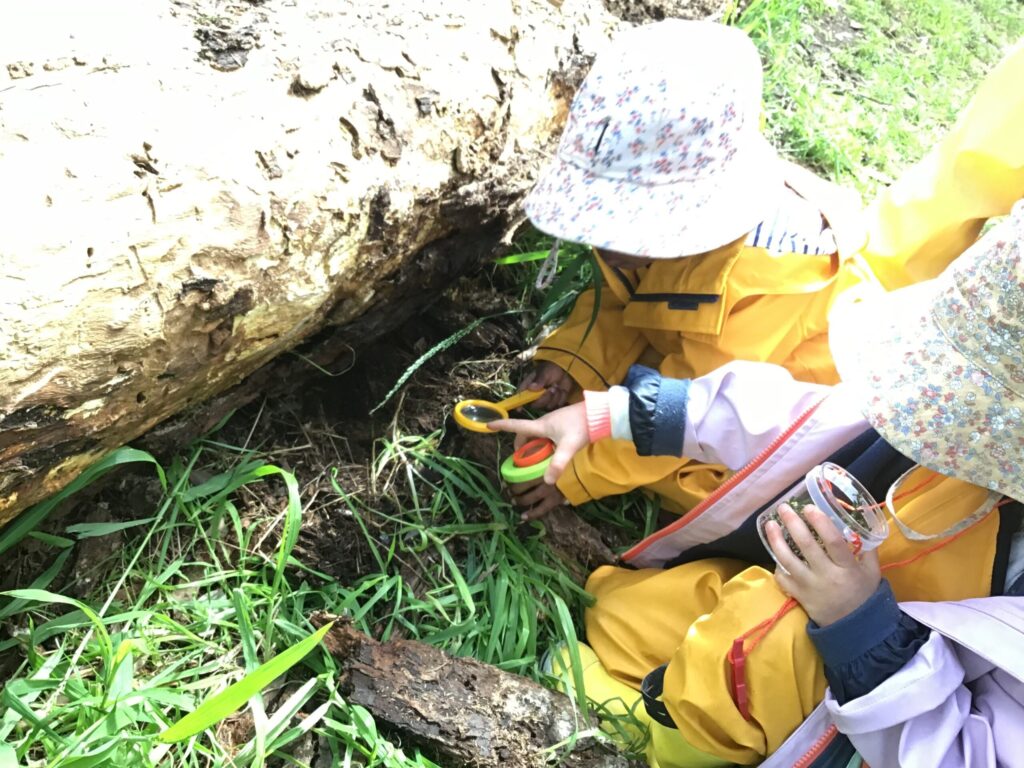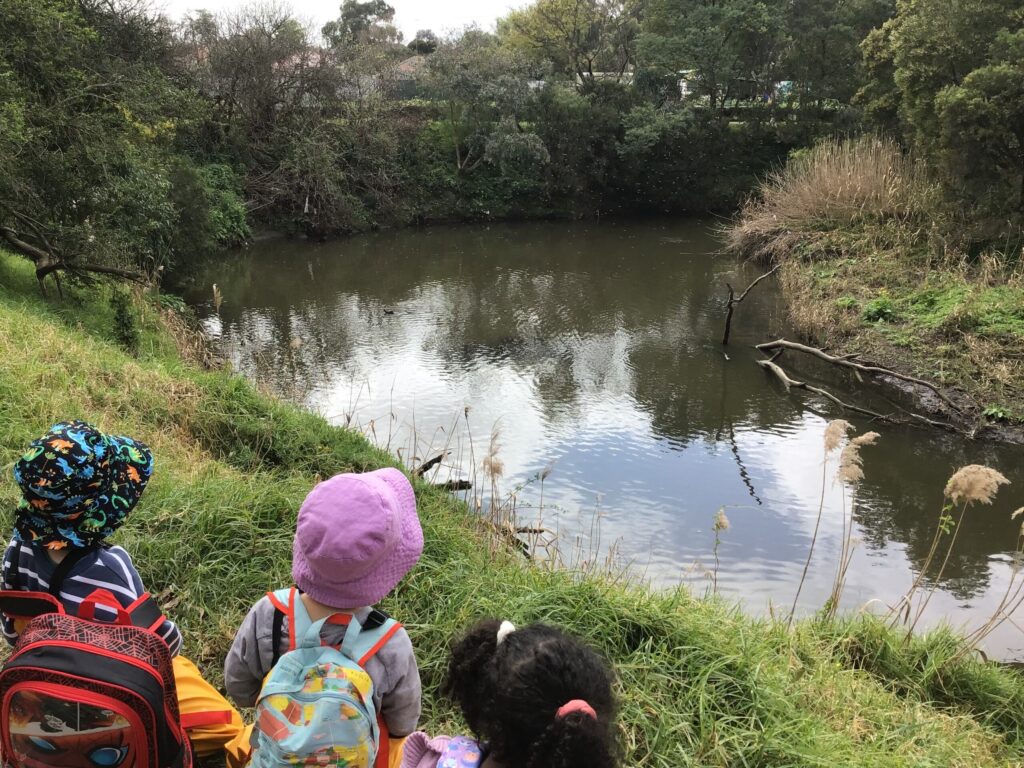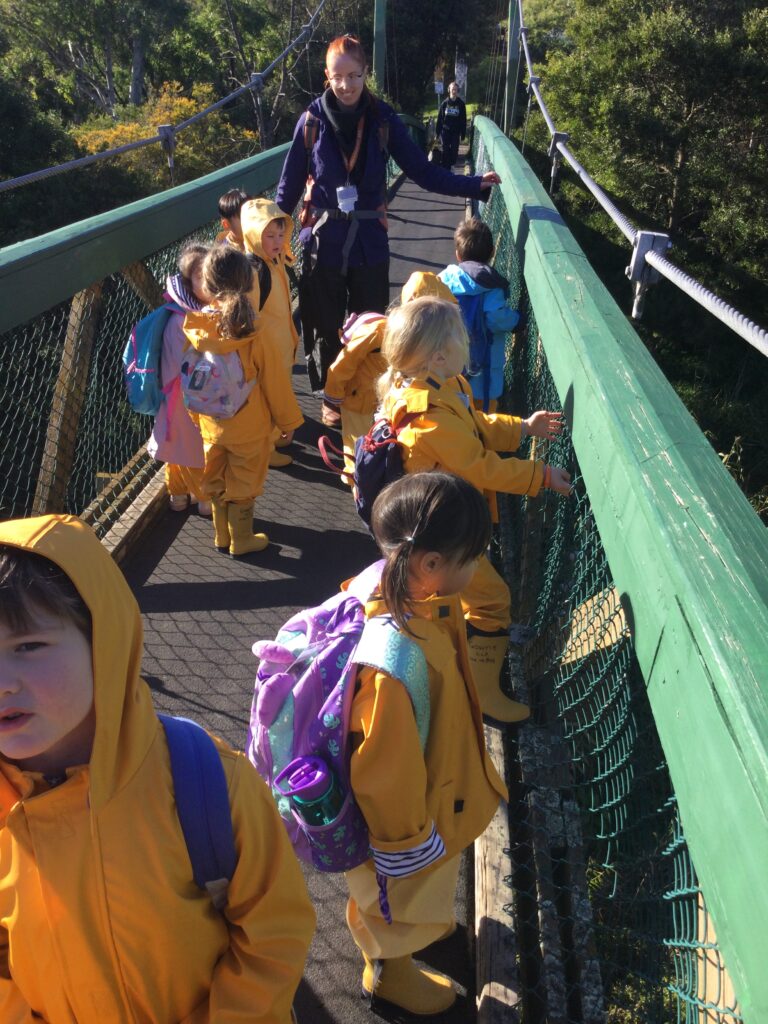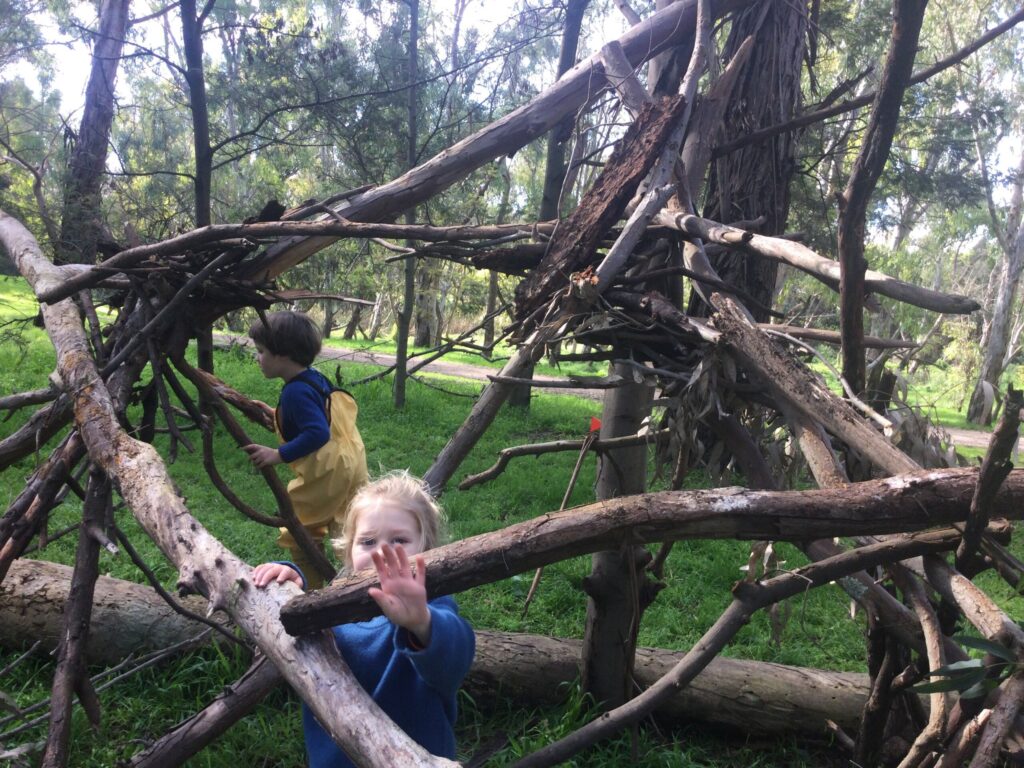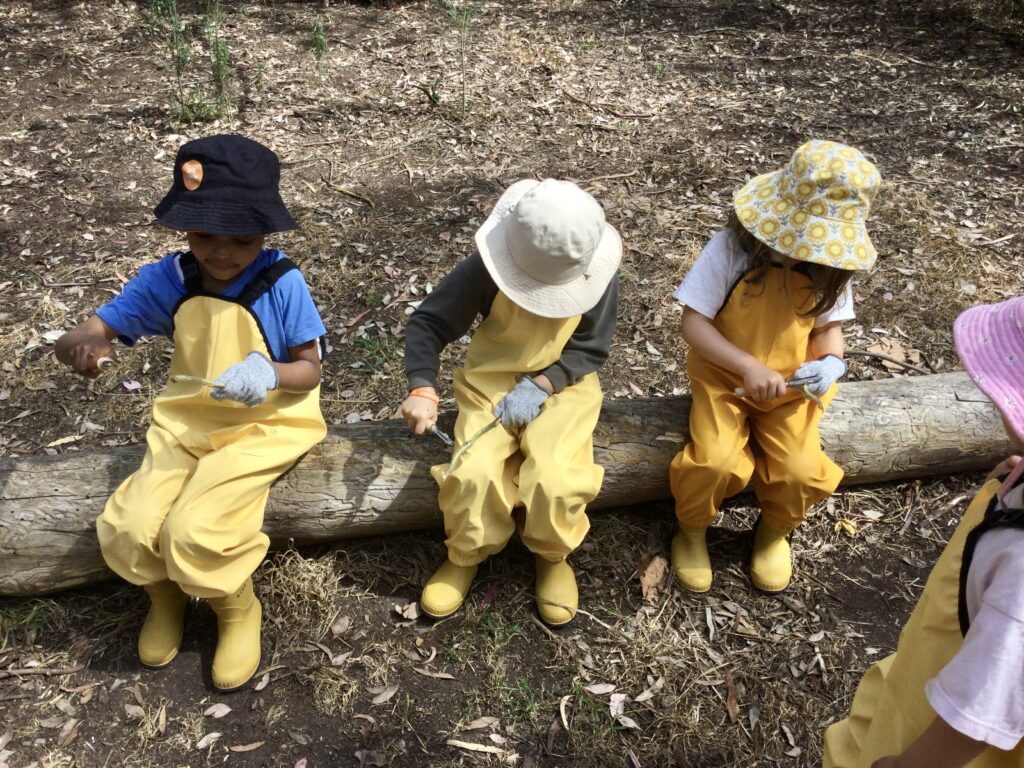Early Childhood Teacher Anneke from our Carlton Learning Precinct (CLP) service has written an article on how the Bush Kinder program is supporting children to develop their language and literacy skills before they transition to school.
The Bush Kinder program at Gowrie Carlton Learning Precinct (CLP) is supporting children from linguistically diverse backgrounds to build language, pre-reading and pre-writing skills in the year before they start school.
There are 23 different home languages spoken in the Golden Wattle Room such as Somali, Vietnamese, Arabic, Thai, Swahili, Indonesian, Cantonese, Oromo, and Aboriginal English, to name a few. Some of the children in Golden Wattle are First Nations Australians while others’ families have recently moved to Melbourne from places like Egypt, Vietnam and Indonesia.
We are a very diverse community, linguistically, culturally and socioeconomically with nearly half of the Golden Wattle children residing in the Carlton public housing towers.
Connecting with nature is important for health and wellbeing especially when you live in the ‘sky’ in high-rise apartments. Connecting with the land and soil helps with feeling grounded, calm and connected to self. When children feel calm, and a sense of belonging then they are ready to learn.
Through our Bush Kinder program children connect with Wurundjeri Woiwurrung Country, and to the people, plants, animals and waterways we share our community with. For the both the older and newer youngest-Australians this builds a sense understanding of and belonging to the local land, landscape and community.
Gowrie CLP received a State Government grant to develop the Bush Kinder program which funded our purchase of gum boots, splash pants, raincoats, and other resources so that socioeconomic status wouldn’t be a barrier to participation.
On Bush Kinder the children are developing many skills and learning dispositions that will help them at school (and life) such as independence, confidence, resilience, respect, and cooperation. Building children’s language, literacy, and communication skills has been a key focus in the classroom this year.
School Readiness Funding enabled the Golden Wattle teachers to become trained through The Australian Literacy and Numeracy Foundations’ Early Language and Literacy (EL&L) program. This teaching and learning is extended when we go out into the wider community. Across the week we take up to 24 Golden Wattle children to the Merri Creek in Coburg for the Bush Kinder program and we travel there together on the tram.
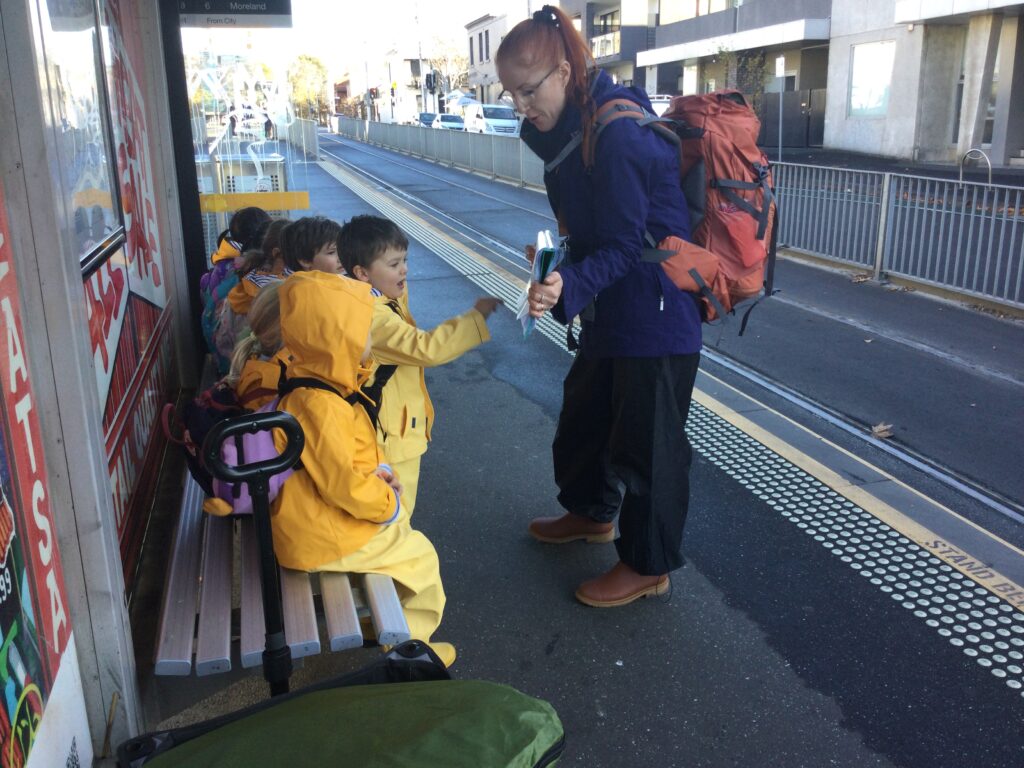
Expanding vocabulary through real life experiences such as catching a tram
Expanding children’s vocabulary through real-life experiences and interactions with our community.
Getting out and about expands the children’s realm of experience and provokes interaction and discussion.
On the tram on the way to bush kinder we have spontaneous and authentic interactions. “Hi, my name is Anas, do you have any kids?” asked Anas to the man he was sharing a seat with. “How many kids do you have and what are their names?”
The people we meet and the things we see are provocations for back and forwards interactions and this expands the children’s vocabulary in meaningful and memorable ways. The people we have met so far have all been very positive and delighted by seeing the children out and about in their community.
“There are 12 children in our group, and we are travelling to stop 133,” said Bodie to the tram driver. The tram drivers have been very friendly too, even helping us to disembark.
Having fun with words and remodelling lots of descriptive language also expands vocabulary.
On Bush Kinder we role model lots of descriptive language and adjectives. There is a ‘wibbly wobbly’ bridge where the wood scrapes and creaks as we cross over the creek. ‘Creak’ and ‘creek’ sound like the same word but they have different meanings and spellings. This is an example of a homophone. Creak also sounds like the word it describes and this is an example of an onomatopoeia. The word ‘quack’ is another.
Tuning into sounds in nature builds children’s awareness of sounds including of the sounds letters make in words (phonology). The water sparkles and ripples below and we look at the shapes the ducks make as they quack and swim across the water of the Merri Creek.
“The ducks are making an O shape on the water and there are lots of Os getting bigger and bigger,” said Yuna. “OOOOOO”, said Sakariya, making the sound that lots of Os would make. “I can see a duck swimming and it’s making a V shape,” said Yara as she makes the sound of a letter V. “V for Very or Volcano.”
Phonemic awareness is about turning into the sounds in words and EL&L is a phonological awareness program.
Children who tune into sounds in words are more likely to recognise words in print if they are already in their vocabulary.
On Bush Kinder we build phonemic awareness by listening to the sounds in nature, pointing them out and noticing the direction the sound is coming from. Can you hear the ascending call of the magpie’s warble? Which tree is it singing in?
We listen to croaking frogs and the barking of cheeky dogs. There are fat and juicy witchetty grubs to discover under logs. Frogs, dogs, and logs rhyme! They end with an ‘og’ sound. How does the ‘og’ sound feel in your mouth? Notice the shapes of your lips, the movement of your tongue and how under your chin rises with the ‘g’.
We love playing with sounds, words, rhymes, and syllables on Bush Kinder and all these experiences improve vocabulary, phonemic awareness, and reading development.
Having a larger vocabulary leads to greater comprehension skills, which is the eventual purpose of reading (‘No Child Left Behind’ study – Marilyn Jager Adams, pg 44, EL&L Manual Section 3-4).
Learning to write through whittling and making the invisible visible.
Whittling is a popular pastime on Bush Kinder. Not only is ‘whittling’ a great word, it is the activity of peeling the bark of a stick with a sharp tool, and this builds fine motor strength and coordination skills which are necessary for handwriting.
When the children sit on the large log to whittle their sticks there needs to be a safety gap between each child. A written sentence is made up of words and between each word there is also a gap/space.
As the children sit spaced on the log, we build sentences from left to right and point out that a sentence has a capital letter at the start and a full stop at the end. This is a multisensory way to learn about sentences and we are bringing to children’s attention a lot of discoveries about sentences.
Another way we teach writing is by bringing attention to directional language. Over the bridge, under the log, behind the leader, in front of the trolley, around the tree are examples of directional and positional language used regularly at bush kinder.
Learning to draw letters is about understanding tall lines, short lines, slanted lines and circle shapes and training eyes to discern the small but distinguishing features of letters. At Bush Kinder we do this by discussing different shaped sticks and finding letter patterns and shapes in the tree roots. “This stick is making the letter K,” says Patrick. “It has a long straight line and two smaller diagonal lines.”
We also make crayon rubbings of squiggly patterns in wood and write directly into the earth and share stories with each other. “What language do trees talk?” wonders Evelyn. “I think they have a quiet language we don’t hear,” she said. “Here’s a drawing [crayon bark rubbing] of me listening to the tree.”
“That tree over there is smiling,” said Lily, “and the wind has a beautiful message. I love you trees.”
The Golden Wattle children have listened to the trees and similar to the trees on Bush Kinder have developed grounded and connected foundations to nature, place, self, each other and to learning.
From these solid roots, our diverse range of learners have built their language, vocabulary and communication skills and are ready for school next year with reading and writing to flourish.
